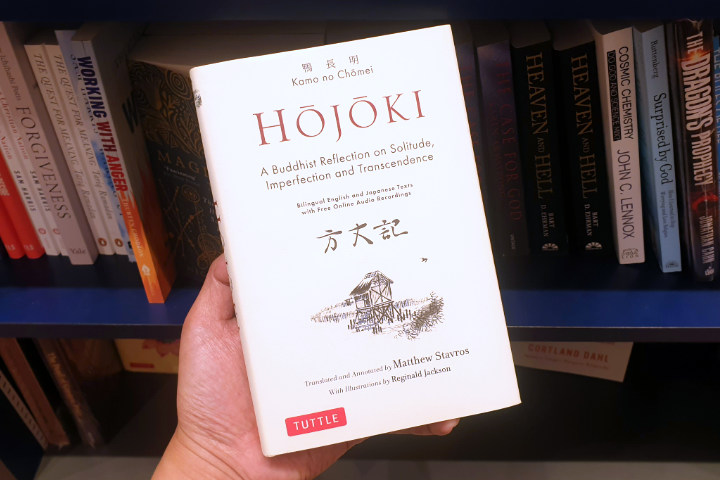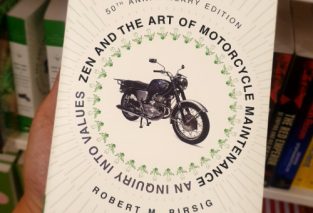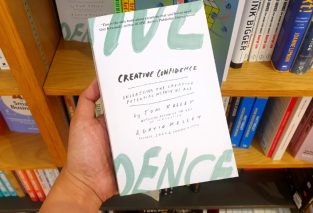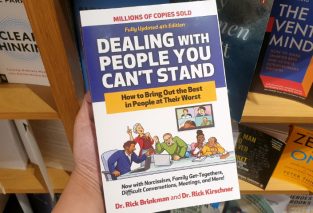Reflect on the fleeting nature of life and the beauty of simplicity. Explore themes of impermanence, solitude, and the search for meaning through personal experiences in a changing world.

The book Hojoki was originally authored by Kamo no Chomei. This particular piece of work, is masterfully translated by Matthew Stavros.
It is a deeply introspective art in written form that intertwines the personal and the universal in a manner that transcends its medieval Japanese origins.
Its succinct yet profound narrative paints a picture of a world caught between the grip of nature’s vast power and humanity’s fragile impermanence.
Written in the early 13th century, set against the backdrop of the tumultuous world, Chomei’s reflections on life, suffering, and the transitory nature of existence seem more relevant today than ever, making this translation both a timeless and modern masterpiece.
At the heart of the book lies an exploration of what it means to truly understand the impermanence of life.
It captures the essence of his quest for simplicity amidst chaos.
The original author, a recluse who withdrew from the chaotic world after witnessing the downfall of his own life in the wake of personal loss and societal upheaval, opens the door to his mind with an unflinching gaze.
He lays bare the bitter truth of life’s fragility in the face of nature’s uncontrollable forces.
From fire to flood, war to famine, his narrative serves as a testament to the unrelenting nature of the world, the calamities that never cease, and the futility of human efforts to control or avoid them.
Yet, there is a peculiar wisdom in his acceptance of this. Rather than resigning himself to despair, he turns to detachment and a quiet form of enlightenment.
Chomei’s world may have been one of social and natural collapse, but his response to it is one of resolute introspection.
His retreat to a mountain hut, in which he meditates on the illusory nature of all things, demonstrates his understanding of human suffering not as an anomaly, but as an intrinsic part of life.
As such, he cultivates a profound inner peace, one that is unshaken by external disasters.
And yet, in a book that might be considered a lamentation on the futility of existence, there is also a thread of wry humor, a subtle acknowledgment of the absurdity of it all.
It’s almost as if Chōmei were in on a cosmic joke, one where life’s constant upheavals were just another form of performance art.
Matthew Stavros’ translation of Hōjōki is remarkable in its ability to capture the ethereal quality of Chōmei’s language while remaining accessible to the modern reader.
It does an admirable job of not only preserving the nuances of the original text but also breathing new life into it through careful language choices that resonate with contemporary readers.
The rhythmic cadence of the original reflections in Japanese, his meditative prose, and his occasional, almost ironic observations, shine through clearly in this translation.
From the very first lines, Stavros’s translation brings to life Chomei’s poetic reflections on the transience of existence. The prose flows like a gentle stream, carrying with it the weight of Chomei’s observations on life’s fleeting nature.
Through vivid imagery and poignant insights, he contrasts the ephemeral nature of human constructs with the enduring cycle of the natural world. The words resonate with a quiet intensity, inviting readers to ponder their own place within the grand tapestry of life.
Through Stavros’ efforts, readers are transported back to an era of profound philosophical contemplation while being firmly grounded in the present day.
Shortcomings
The meditative style of Hōjōki is both its strength and, arguably, its limitation.
On one hand, the short, almost aphoristic nature of the text invites deep reflection and careful thought. It does not overwhelm the reader with long-winded philosophical discourse but presents his reflections in brief, digestible fragments.
This lends the book a sense of clarity, allowing readers to explore ideas without getting lost in the complexity of the prose.
However, it is this same brevity that can be a double-edged sword.
Because while the reflections are deeply insightful, they can also leave the reader wanting more.
The narrative is intensely personal, centered on Chomei’s solitary experiences and contemplations.
There are moments in the text where you wish that it would expand further on a particular thought or idea, but the text quickly moves on, never lingering too long on any one subject. It occasionally suffers from an over-reliance on the abstract.
This fleeting quality of the text, while thematically fitting in terms of its meditation on impermanence, can also feel frustrating at times.
In some instances, the depth of ideas seems cut short, leaving room for a richer, more expansive exploration of his philosophy.
In focusing so intently on the ephemeral, it sometimes sacrifices the richness of tangible experience for the sake of conceptual reflection.
It is as if, at times, the poetry of his words veils the very thing they seek to understand. Which is the living experience of being human.
The reader is left wondering what might happen if Chōmei allowed for a little more of the messy, unpolished details of life to enter the fold of his meditation.
One might argue that even in a world that seems doomed to destruction, there’s still room for human folly and joy. And perhaps that is what Hōjōki could benefit from. A deeper dive into the ways in which the ephemeral beauty of life is intertwined with its messier, more chaotic moments.
I have to admit that I was gasping for more.
For example, In one of the book’s more somber moments, it talks about the flow of the river being constant, and yet it does not persist for even a single moment. A metaphor for the transient nature of all things. It’s a beautiful sentiment, but one that, in its all-encompassing scope, fails to acknowledge the small, lasting impacts that life’s fleeting moments can have.
What if Chōmei explored more fully the possibility that impermanence doesn’t have to mean nothingness? That the fleeting can still be meaningful?
An exploration of how Chomei’s insights intersect with the broader currents of Japanese history could enrich the narrative and provide readers with a more comprehensive understanding.
Biggest Takeaway
The greatest takeaway from Hojoki lies in its invitation to embrace the impermanence of life rather than fear it.
And simplicity as a path to enlightenment.
There is no advocating for passivity in the face of suffering but rather suggests a method of accepting the ebb and flow of life, no matter how tumultuous it may be.
There is a resonance in his work for anyone who has grappled with personal loss or witnessed the breakdown of societal structures, as the author’s experiences are universal in their despair yet uniquely personal in their resolution.
His retreat into nature, which might at first seem like an escape, is actually an assertion of presence. He is not running away from life’s hardships but choosing to exist within them with quiet acceptance.
In this way, the underlying message is not one of resignation, but one of liberation.
In relinquishing material desires and societal expectations, he finds freedom and contentment within himself. This message is particularly resonant in today’s fast-paced world, where the pursuit of external success often overshadows inner fulfillment.
This is ultimately an ancient text that rewards patience and careful contemplation.
It offers a chance to witness one man’s reckoning with a world in flux, and in doing so, it asks us to consider how we might approach our own lives, so deeply embedded in the currents of change.
Through the reflections, readers are invited to confront their own fears, doubts, and uncertainties, and to find in them not despair, but perhaps, a deeper sense of connection to the world around them.
The beauty of Hōjōki lies not in its answers but in the quiet space it creates for its readers to search for their own.
The philosophical depth is not the only thing that resonates.
The sheer elegance of the writer’s prose, delicate and clear like a river stream (though, just like that river, a little bit more unpredictable) makes the book a literary treat.
And though the text may not offer the most comprehensive answers to life’s greatest questions, one could say it does offer a refreshing approach to life’s most complicated riddle.
So, in a way, it’s not so much about the “what” of life, but the “how” we choose to reflect on it.
Perhaps, in the end, Chōmei was onto something after all. Sometimes, the best way to weather life’s storms is simply to sit back, relax, and let them pass by.
True peace lies not in what we possess but in how we perceive the world around us.




